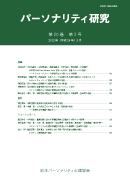Volume 20, Issue 3
Displaying 1-10 of 10 articles from this issue
- |<
- <
- 1
- >
- >|
Articles
-
Article type: Article
2012 Volume 20 Issue 3 Pages 143-154
Published: March 30, 2012
Released on J-STAGE: May 22, 2012
Download PDF (693K) -
Article type: Article
2012 Volume 20 Issue 3 Pages 155-166
Published: March 30, 2012
Released on J-STAGE: May 22, 2012
Download PDF (671K) -
Article type: Article
2012 Volume 20 Issue 3 Pages 167-178
Published: March 30, 2012
Released on J-STAGE: May 22, 2012
Download PDF (840K) -
Article type: Article
2012 Volume 20 Issue 3 Pages 179-192
Published: March 30, 2012
Released on J-STAGE: May 22, 2012
Download PDF (1107K) -
Article type: Article
2012 Volume 20 Issue 3 Pages 193-203
Published: March 30, 2012
Released on J-STAGE: May 22, 2012
Download PDF (733K)
Exploratory Reports
-
Article type: Exploratory Report
2012 Volume 20 Issue 3 Pages 204-216
Published: March 30, 2012
Released on J-STAGE: May 22, 2012
Download PDF (1045K) -
Article type: Exploratory Report
2012 Volume 20 Issue 3 Pages 217-228
Published: March 30, 2012
Released on J-STAGE: May 22, 2012
Download PDF (993K)
Short Reports
-
Article type: Short Report
2012 Volume 20 Issue 3 Pages 229-232
Published: March 30, 2012
Released on J-STAGE: May 22, 2012
Download PDF (634K) -
Article type: Short Report
2012 Volume 20 Issue 3 Pages 233-235
Published: March 30, 2012
Released on J-STAGE: May 22, 2012
Download PDF (565K) -
Article type: Short Report
2012 Volume 20 Issue 3 Pages 236-239
Published: March 30, 2012
Released on J-STAGE: May 22, 2012
Download PDF (715K)
- |<
- <
- 1
- >
- >|
